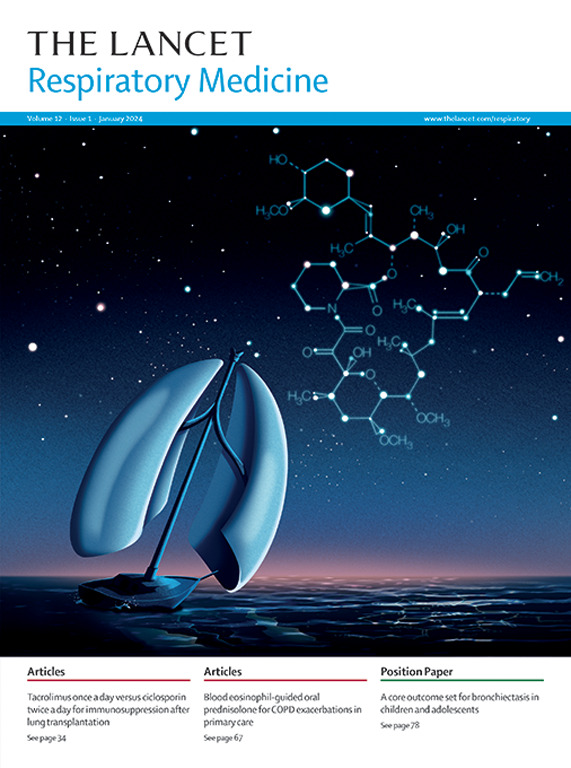Global, regional, and national burden of asthma and atopic dermatitis, 1990–2021, and projections to 2050: a systematic analysis of the Global Burden of Disease Study 2021
IF 38.7
1区 医学
Q1 CRITICAL CARE MEDICINE
引用次数: 0
Abstract
Background
Asthma and atopic dermatitis are common allergic conditions that contribute to substantial health loss, economic burden, and pain across individuals of all ages worldwide. Therefore, as a component of the Global Burden of Diseases, Injuries, and Risk Factors Study (GBD) 2021, we present updated estimates of the prevalence, disability-adjusted life-years (DALYs), incidence, and deaths due to asthma and atopic dermatitis and the burden attributable to modifiable risk factors, with forecasted prevalence up to 2050.Methods
Asthma and atopic dermatitis prevalence, incidence, DALYs, and mortality, with corresponding 95% uncertainty intervals (UIs), were estimated for 204 countries and territories from 1990 to 2021. A systematic review identified data from 389 sources for asthma and 316 for atopic dermatitis, which were further pooled using the Bayesian meta-regression tool. We also described the age-standardised DALY rates of asthma attributable to four modifiable risk factors: high BMI, occupational asthmagens, smoking, and nitrogen dioxide pollution. Furthermore, as a secondary analysis, prevalence was forecasted to 2050 using the Socio-demographic Index (SDI), air pollution, and smoking as predictors for asthma and atopic dermatitis. To assess trends in the burden of asthma and atopic dermatitis before (2010–19) and during (2019–21) the COVID-19 pandemic, we compared their average annual percentage changes (AAPCs).Findings
In 2021, there were an estimated 260 million (95% UI 227–298) individuals with asthma and 129 million (124–134) individuals with atopic dermatitis worldwide. Asthma cases declined from 287 million (250–331) in 1990 to 238 million (209–272) in 2005 but increased to 260 million in 2021. Atopic dermatitis cases consistently rose from 107 million (103–112) in 1990 to 129 million (124–134) in 2021. However, age-standardised prevalence rates decreased—by 40·0% (from 5568·3 per 100 000 to 3340·1 per 100 000) for asthma and 8·3% (from 1885·4 per 100 000 to 1728·5 per 100 000) for atopic dermatitis. In 2021, there were substantial variations in the burden of asthma and atopic dermatitis across different SDI groups, with the highest age-standardised DALY rate found in south Asia for asthma (465·0 [357·2–648·9] per 100 000) and the high-income super-region for atopic dermatitis (3552·5 [3407·2–3706·1] per 100 000). During the COVID-19 pandemic, the decline in asthma prevalence had stagnated (AAPC pre-pandemic –1·39% [–2·07 to –0·71] and during the pandemic 0·47% [–1·86 to 2·79]; p=0·020); however, there was no significant difference in atopic dermatitis prevalence in the same period (pre-pandemic –0·28% [–0·33 to –0·22] and during the pandemic –0·35% [–0·78 to 0·08]; p=0·20). Modifiable risk factors were responsible for 29·9% of the global asthma DALY burden; among them, high BMI was the greatest contributor (39·4 [19·6–60·2] per 100 000), followed by occupational asthmagens (20·8 [16·7–26·5] per 100 000) across all regions. The age-standardised DALY rate of asthma attributable to high BMI was highest in high-SDI settings, whereas the contribution of occupational asthmagens was highest in low-SDI settings. According to our forecasting models, we expect 275 million (224–330) asthma cases and 148 million (140–158) atopic dermatitis cases in 2050, with population growth driving this increase. However, age-standardised prevalence rates are expected to remain stable (–23·2% [–44·4 to 5·3] for asthma and –1·4% [–9·1 to 7·0] for atopic dermatitis) from 2021 to 2050.Interpretation
Although the increases in the total number of asthma and atopic dermatitis cases will probably continue until 2050, age-standardised prevalence rates are expected to remain stable. A considerable portion of the global burden could be managed through efforts to address modifiable risk factors. Additionally, the contribution of risk factors to the burden substantially varied by SDI, which suggests the need for tailored initiatives for specific SDI settings. The growing number of individuals expected to be affected by asthma and atopic dermatitis in the future suggests that it is essential to improve our understanding of risk factors for asthma and atopic dermatitis and collect disease prevalence data that are globally generalisable.Funding
Gates Foundation.求助全文
约1分钟内获得全文
求助全文
来源期刊

Lancet Respiratory Medicine
RESPIRATORY SYSTEM-RESPIRATORY SYSTEM
CiteScore
87.10
自引率
0.70%
发文量
572
期刊介绍:
The Lancet Respiratory Medicine is a renowned journal specializing in respiratory medicine and critical care. Our publication features original research that aims to advocate for change or shed light on clinical practices in the field. Additionally, we provide informative reviews on various topics related to respiratory medicine and critical care, ensuring a comprehensive coverage of the subject.
The journal covers a wide range of topics including but not limited to asthma, acute respiratory distress syndrome (ARDS), chronic obstructive pulmonary disease (COPD), tobacco control, intensive care medicine, lung cancer, cystic fibrosis, pneumonia, sarcoidosis, sepsis, mesothelioma, sleep medicine, thoracic and reconstructive surgery, tuberculosis, palliative medicine, influenza, pulmonary hypertension, pulmonary vascular disease, and respiratory infections. By encompassing such a broad spectrum of subjects, we strive to address the diverse needs and interests of our readership.
 求助内容:
求助内容: 应助结果提醒方式:
应助结果提醒方式:


